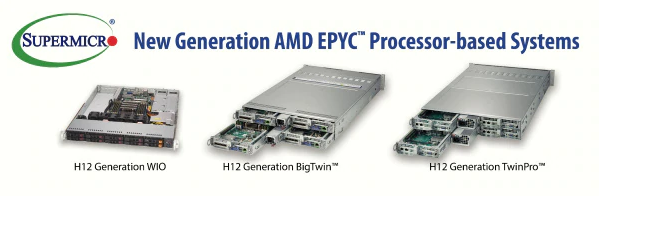New Supermicro H12 A+ Servers Set World Record Benchmarks and Deliver Superior Performance with AMD EPYC™ 7002 Series Processors
SAN JOSE, Calif., August 7, 2019 — Super Micro Computer, Inc. (SMCI), a global leader in enterprise computing, storage, networking solutions, and green computing technology, today launched its first
family of new H12 generation A+ Servers optimized to deliver a new level of integration and superior performance for modern datacenters with AMD EPYC™ 7002 Series Processors.
Supermicro’s new H12 A+ servers with the 2nd Gen AMD EPYC™ processors are expected to deliver up to two times the performancei with double the core count compared to 1st Gen AMD EPYC™ processor-based systems. With these new A+ Servers, customers can also expect improved GPU accelerator performance as well as up to four times the peak FLOPS per socket.ii
Supermicro delivered world-record performance benchmarks on its new H12 A+ Servers for both TPCx-IoT, and TPC-DS categories. For TPCx-IoT, performance of 472200.88 IoTps was established on Supermicro’s H12 TwinPro™ 2U 4-node server where faster IoT gateway data analytics are critical for the coming explosion of IoT device numbers. This is especially with the massive bandwidth increase enabled by 5G networks. A new world record for TPC-DS was achieved using a Supermicro H12 A+ BigTwin system. This server delivers the highest performance and lowest performance per dollar for a 10TB database with 64% higher QphDS throughput (Composite Query per Hour Metric) and $0.05 savings per QphDS over the previous world record holders.
“Supermicro’s industry-leading H12 A+ servers leveraging AMD’s EPYC 7002 series processors provide an ideal combination of features for modern data centers including robust virtualization performance, up to 64 high-performance cores per socket, a maximum of 128 threads per socket, and onboard disk controllers to mitigate memory access bottlenecks,” said Ismail Sayeeduddin, Corporate Vice President, Sales and Business Operations. “Supermicro’s H12 A+ servers are available in multiple optimized configurations and storage densities to address customer requirements.”
“We’re excited and thankful to have our partners supporting the launch of AMD EPYC 7002 Series Processors,” said Scott Aylor, corporate vice president and general manager, Datacenter Solutions Group, AMD. “Their EPYC based solutions are poised to deliver a new standard for modern datacenter customers. With twice the cores, breakthrough performance and embedded security features, all delivered by a leadership architecture, customers can transform their datacenter operations at the pace of their business.”
Furthermore, these new Supermicro A+ Servers offer increased data center agility and responsiveness with a comprehensive and balanced feature set of I/O, memory, and security capabilities. As the first generation of systems with PCI-E® 4.0 support, these A+ Servers feature a large memory footprint of up to four terabytes (4TB) per socket running fast DDR4 memory up to 3200MHz.
Supermicro offers an industry-leading portfolio of AMD EPYC™ based systems and Server Building Block Solutions®. From single-socket mainstream and WIO servers to high-end Ultra server systems and multi-node systems, including BigTwin™ and TwinPro™, Supermicro enables customers to build application-optimized solutions with a multitude of configuration possibilities.
These new 2nd Gen AMD EPYC™ processors are also socket compatible with Supermicro H11 generation systems (drop-in support for board rev 2.x). This provides new and existing customers on the H11 gen systems a fast upgrade track when PCI-E® 4.0 support is not a necessity. Existing Supermicro H11 solutions are still uniquely competitive in the market as they can support up to DDR4-3200MHz memory.iii

For complete information on Supermicro products, visit
www.supermicro.com.
Follow Supermicro on
Facebook and
Twitter to receive their latest news and announcements.
About Super Micro Computer, Inc. (NASDAQ: SMCI)
Supermicro (NASDAQ: SMCI), the leading innovator in high-performance, high-efficiency server technology is a premier provider of advanced server Building Block Solutions® for Data Center, Cloud Computing, Enterprise IT, Hadoop/Big Data, HPC and Embedded Systems worldwide. Supermicro is committed to protecting the environment through its “We Keep IT Green®” initiative and provides customers with the most energy-efficient, environmentally-friendly solutions available on the market.
Supermicro, Building Block Solutions and We Keep IT Green are trademarks and/or registered trademarks of Super Micro Computer, Inc.
All other brands, names and trademarks are the property of their respective owners.
Media Contact:
Greg Kaufman
Super Micro Computer, Inc.
pr@supermicro.com
SMCI-F
i Projections as of July 3, 2019 for AMD EPYC processors using computer modeling of preproduction parts and SPECrate® 2017_int_base internal testing results. Results may vary with production silicon testing. EPYC 7601 results as of June 2019
http://spec.org/cpu2017/results/res2019q2/cpu2017-20190411-11817.pdf. SPEC®, SPECrate® and SPEC CPU® are registered trademarks of the Standard Performance Evaluation Corporation. See
www.spec.org for more information. ROM-23
ii Estimated generational increase based upon AMD internal design specifications for “Zen 2” compared to “Zen”. “Zen 2” has 2X the core density of “Zen”, and when multiplied by 2X peak FLOPs per core, at the same frequency, results in 4X the FLOPs in throughput. Actual results with production silicon may vary.
iii Some supported features and functionality of second generation AMD EPYC™ processors (codenamed “Rome”) require a BIOS update from your server manufacturer when used with a motherboard designed for the first generation AMD EPYC 7000 series processor. A motherboard designed for “Rome” processors is required to enable all available functionality. ROM-06

